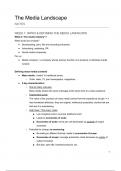The Media Landscape
NOTES
WEEK 1: INTRO & DEFINING THE MEDIA LANDSCAPE
What is “the media industry”?
What would you include?
● Broadcasting, print, film and recording industries
● Advertising, marketing, PR
● Social media companies
For us:
● Media company = a company whose primary function is to produce or distribute media
content.
Defining mass media (content)
● Mass media: “media” in traditional sense
○ Think: radio, TV, print newspapers, magazines…
● 5 key characteristics:
○ One to many, one-way
Mass media shares the same message at the same time to a mass audience.
○ Experiential goods
The value of the products of mass media comes from the experience we get -> it
has immaterial attributes: they are original, intellectual properties, stories that are
told and it is entertaining.
○ High fixed / “first copy” costs
■ Low marginal costs (=cost per additional unit)
■ Leads to economies of scale
■ Economies of scale= price per unit decreases as quantity of output
increases
○ Potential for (cheap) re-versioning:
■ Re-selling in different formats, leads to economies of scope
■ Economies of scope= average production costs decrease as variety of
output increases
■ But also: spin-offs, branded products, etc.
1
, ○ High risk
■ Consumer taste is ‘fickle’ and hard to predict
■ High first copy costs regardless # of consumers
■ Not just movies…newspapers, magazines, books, radio programmes,
television shows…
■ Box office of movie may affected by:
● [note: covid as possibly relevant factor]
● But “bomb” is only a budgetary connotation
○ Everyone has unique taste→ high risk, it does not mean
they are bad movies
Defining mass media market
● Dual-product market
○ Media companies produce 2 things:
■ Content, sold to audiences
■ Audiences, sold to advertisers
● The bulk of the financial products in media companies comes from
advertising. Their job is to produce content that attracts viewers
“eyeballs” to attract advertisers.
● “Attention economy”
○ Attention is the real product being sold/ bought
○ It's not a media product being sold, it is the attention of the audience that is in the
real product.
● Why should we care? (the outcomes of the attention economy)
● Result: advertising goals influence content/ strategy
○ More newspapers become tabloids which is problematic for journalists
■ Problematic for journalism, particularly
■ But also artists: Change ending of the movie, otherwise it too
depression
● Broader tension:
○ creative industries versus commercial needs
The mass media market is changing
● Digitalization / digital technologies are biggest force of change
● 4 main outcomes:
2
, ○ Convergence: previously separate channels fused; conduits (telecoms), content
(media) & computing (IT)
○ Interactivity: two-way replaces one-way; users become (mass) producers
○ Diversification: heightened user control & choice; fragmentation / expansion of
content
○ (key outcome of digitalisation) Mobility: media ‘on the go’ becomes norm;
‘always on’ culture
Why is mass media changing?
● Technological innovations
● ‘Rise of digital media’ (digitalization)
● Very different to the 5 characteristics of traditional mass media
● Focus of next weeks; for Hodkinson, digitalization / digital technologies are biggest force
of change
What is digital media defined as?
● Based on computing technologies
● Use digital information
● Delivery via internet
Media has responsibilities? To care about the media changes
● Media organizations (at least some?)
○ Should be socially responsible.
● A few core CSR for media organizations:
○ Exchanging ideas / opinions
○ Integrating / cohering diverse societies
○ Protecting core values / vulnerable audiences (no alcohol in children shows etc)
High stakes
● Media companies have potentially significant influence on (young) (vulnerable)
audiences
○ Who gets a voice (and who doesn’t)
○ How they are represented (and by whom)
○ Which values are shown, elevated (and which not)
3
, ○ … … All of these matters
● So, we should care about how the industry functions
● Bottom line = high stakes (gambling)
Therefore: strong reactions to change
● McLuhan’s optimism (+): the social impact of the media was that they became an
extension of the human senses, and altered the social world.
○ Technology itself matters
○ New tech. extends senses
○ New, ‘cooler’, media:
■ Liberate (解放) audiences from hierarchies, isolation
■ Away from officialdom toward everyday talk’
■ Toward a global village
(More) strong reactions to change
● Postman’s pessimism (-): the decline of the communication medium as the invention of
television begins to replace print. He asserts that television is turning important matters
into entertainment. Therefore, the images displayed are more important than the
information being spread.
○ Print age: detailed, relevant, localized, coherent, rational
○ Post-telegraph: dazzling stories from afar outweigh the relevant, local
○ TV/image → superficiality
○ Attention, rationality
○ Passive audience
○ Link to media myths
Critiques of these critiques
● Both approaches ignore the social context around us= technological determinism
○ Technological determinism= that technology itself is primary cause of social
change
● Simplifies & overplays tech, ignores social context
● Ignores power relations behind development / use
○ Optimism: tech as solution to man-made problems
○ Pessimism: blames tech for social problems
4






